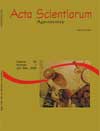<strong>The influence of sample density and interpolation type on the elaboration of thematic maps<strong>
Keywords:
precision agriculture, geostatistics, sampling
Abstract
The objective of this work was to evaluate the influence of the sampling density (three grids) and of the type of interpolation (kriging, inverse of the distance, inverse of the square distance, and polynomial) in the elaboration of thematic maps of soybean yield in an area of Dystroferric Red Nitosol under precision agriculture from 1998 to 2002. The selected grids had 128, 64 and 32 units using stratified systematic aligned sampling (SSAS). The thematic maps was generated from each sampling grid and using each of the interpolators. The relative deviation coefficient (CDR) was proposed to express the average difference in module of the values interpolated in each grid in relation to the considered standard SSAS grid with 128 units and kriging interpolator. The CDR proved efficient in the comparison of maps and made it possible to conclude that to effectively use the entire potential of the kriging, it is necessary to have several points, so that a good semivariogram is constructed. Otherwise, any of the other analyzed interpolators can be used. The SSAS 128 inverse distance method was most similar to the reference, SSAS 128 Kriging.Downloads
Download data is not yet available.
Published
2009-03-19
How to Cite
Coelho, E. C., Souza, E. G. de, Uribe-Opazo, M. A., & Pinheiro Neto, R. (2009). <strong>The influence of sample density and interpolation type on the elaboration of thematic maps<strong>. Acta Scientiarum. Agronomy, 31(1), 165-174. https://doi.org/10.4025/actasciagron.v31i1.6645
Issue
Section
Soils
DECLARATION OF ORIGINALITY AND COPYRIGHTS
I Declare that current article is original and has not been submitted for publication, in part or in whole, to any other national or international journal.
The copyrights belong exclusively to the authors. Published content is licensed under Creative Commons Attribution 4.0 (CC BY 4.0) guidelines, which allows sharing (copy and distribution of the material in any medium or format) and adaptation (remix, transform, and build upon the material) for any purpose, even commercially, under the terms of attribution.
2.0
2019CiteScore
60th percentile
Powered by 

2.0
2019CiteScore
60th percentile
Powered by 



















































